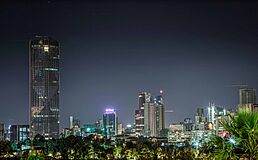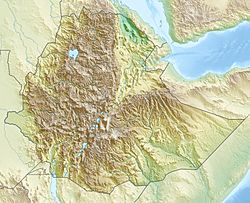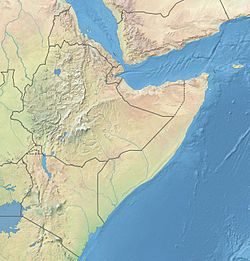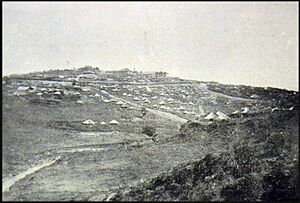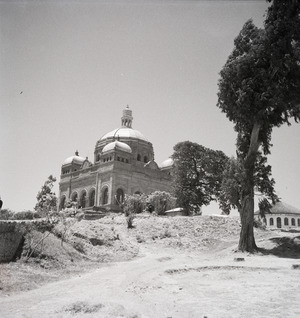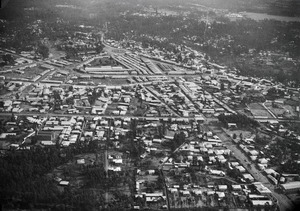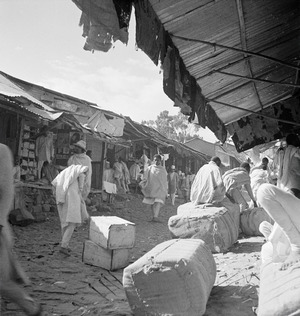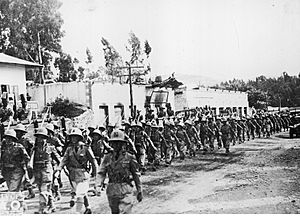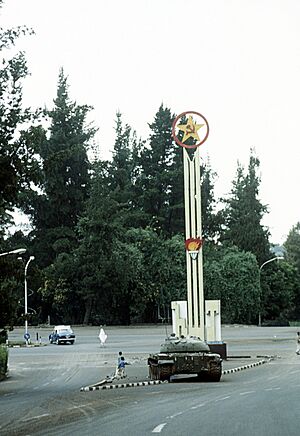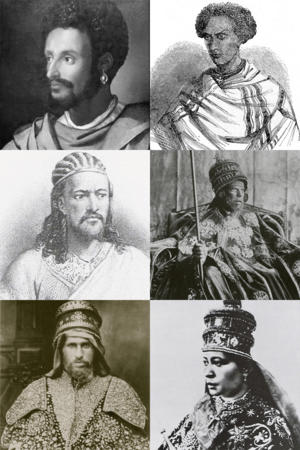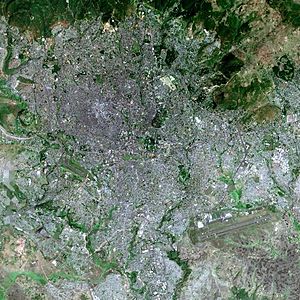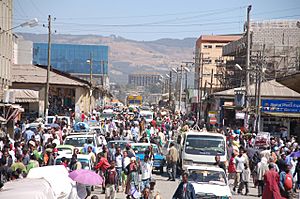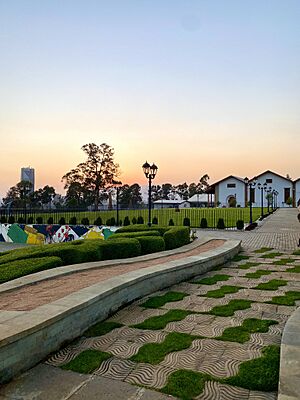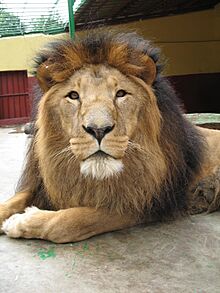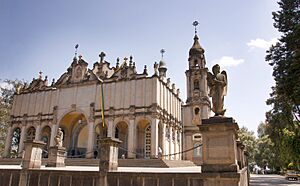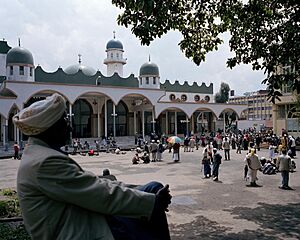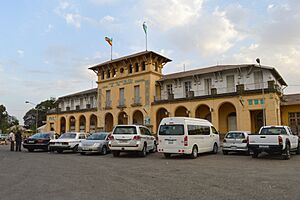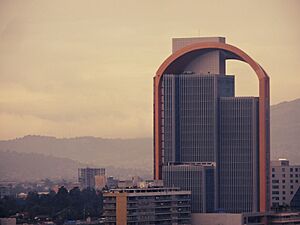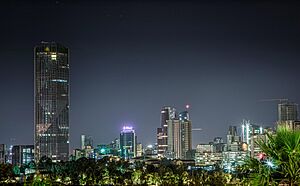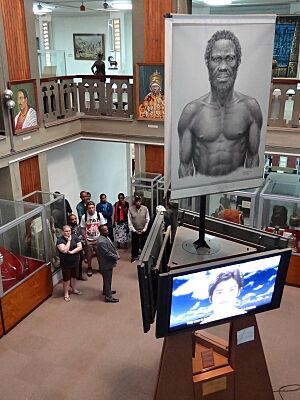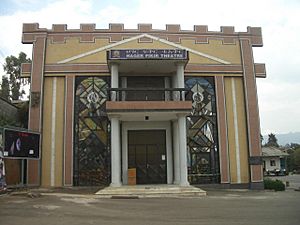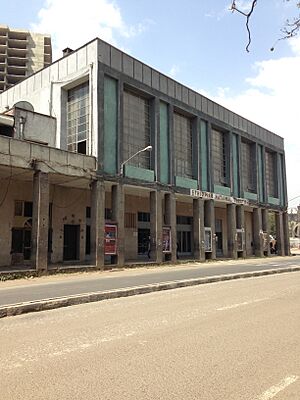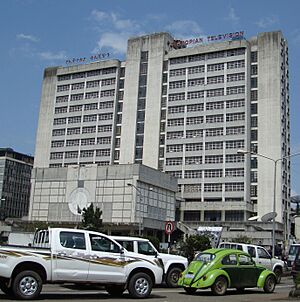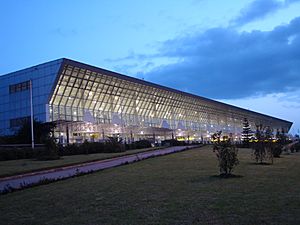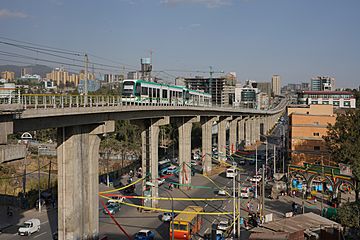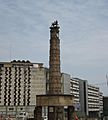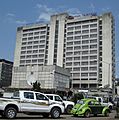Addis Ababa facts for kids
Quick facts for kids
Addis Ababa
|
||
|---|---|---|
|
Capital and chartered city
|
||
|
Skyline of Addis Ababa's Meskel Square
St. George's Cathedral
Addis Ababa University
Holy Trinity Cathedral
Sheger Park
Addis Ababa Light Rail
Grand Anwar Mosque
|
||
|
||
| Nicknames:
City of Humans, Sheger, Adu Genet
|
||

Addis Ababa highlighted inside of Ethiopia
|
||
| Country | Ethiopia | |
| Founded | 1886 | |
| Incorporated as capital city | 1889 | |
| Founded by |
|
|
| Area | ||
| • Capital and chartered city | 527 km2 (203 sq mi) | |
| • Land | 527 km2 (203 sq mi) | |
| Elevation | 2,355 m (7,726 ft) | |
| Population
(2007)
|
||
| • Capital and chartered city | 2,739,551 | |
| • Estimate
(2023)
|
3,945,000 | |
| • Density | 5,165.1/km2 (13,378/sq mi) | |
| • Metro | 5,704,000 | |
| Demonym(s) | Addis Ababan | |
| Time zone | UTC+3 (East Africa Time) | |
| Area code(s) | (+251) 11 | |
| HDI (2021) | 0.741 high · 1st of 11 |
|
Addis Ababa (meaning "new flower" in Amharic) is the capital and largest city of Ethiopia. In 2007, about 2.7 million people lived there. Addis Ababa is a very important center for culture, art, money, and government in Ethiopia. Many people call it one of Africa's main capitals.
The city was started in 1886 by Menelik II, who was the ruler of Shewa. He chose this spot after finding Mount Entoto not very good for a capital. At first, Addis Ababa was a resort town because it had many mineral springs. These springs attracted important people and led them to settle there. It also brought many workers, artists, merchants, and visitors from other countries.
Menelik II built his imperial palace in 1887. Addis Ababa became the capital of the empire in 1889. Soon after, other countries opened their embassies there. The city began to grow a lot in the 20th century, even without a clear plan at first.
In 1926 and 1927, Addis Ababa saw a big economic boost. More middle-class people owned stone houses with furniture from Europe. They also bought new cars and more banks opened. During the time Italy occupied Ethiopia, the city continued to grow and modernize. Later plans for the city's growth were made by experts from France and Britain.
Addis Ababa is a special city that governs itself, according to Ethiopia's constitution. It's known as "the political capital of Africa" because it's very important for diplomacy and politics on the continent. Many big international groups have their main offices here, like the African Union and the United Nations Economic Commission for Africa.
The city is located near the East African Rift, which divides Ethiopia. It is surrounded by the Special Zone of Oromia. People from all over Ethiopia live in Addis Ababa. It is also home to Addis Ababa University. The city has a high Human Development Index, meaning people generally have a good quality of life. It's known for its exciting culture, fashion, and art. Ethiopia is also one of the fastest-growing economies in the world.
Contents
- History of Addis Ababa
- Addis Ababa and the Amhara People
- Addis Ababa and Oromia Regional State
- Geography of Addis Ababa
- People of Addis Ababa
- Economy of Addis Ababa
- Places of Worship
- Architecture of Addis Ababa
- Culture in Addis Ababa
- Sports in Addis Ababa
- Education in Addis Ababa
- Transportation in Addis Ababa
- Sister Cities
- Images for kids
- Notable People from Addis Ababa
- See also
History of Addis Ababa
Early Times in Addis Ababa
Scientists who studied DNA from people around the world think that early humans first left Africa from a place near Addis Ababa. They believe humans spread from this area to the rest of the planet about 100,000 years ago. Their research showed that people's genes become less diverse the further their ancestors traveled from Addis Ababa.
Medieval Period in Addis Ababa
Mount Entoto, a high area north of Addis Ababa, might have been the site of an old imperial capital called Barara. This strong city was built in the 1400s and was home to several emperors until the early 1500s. A map from around 1450 showed the city between Mount Zuqualla and Menegasha. Barara was destroyed in 1529 by Ahmed Gragn. Recent discoveries of a large medieval town on Mount Entoto support this idea. This site, called the Pentagon, has a castle with 12 towers and long stone walls.
Founding of the City
First Settlements in the Area
Before Addis Ababa, the capital was Entoto, started by Menelik II in 1884. Menelik, who was the King of the Shewa province, used Mount Entoto as a military base. In 1879, he visited old ruins and an unfinished church there. His interest grew when his wife, Taytu Betul, started building a church on Mount Entoto. Menelik also supported another church nearby. He wanted to build a big city there. However, Entoto was too cold, didn't have enough water, and lacked firewood.
How Addis Ababa Was Founded
In 1886, people started settling in a valley south of the mountain. This place was called Finfinne, which means "hot springs." Empress Taytu Betul chose the spot. She built her house near the "Filwuha" hot mineral springs, where she and the royal family liked to bathe. Other nobles and their staff also settled nearby.
Menelik expanded his wife's house into the Imperial Palace in 1887. This palace is still the seat of government today. In 1886, the city was renamed Addis Ababa, meaning "new flower." It became the capital of Ethiopia in 1889 when Menelik became Emperor. The city grew very quickly. Not just nobles, but also many workers, artists, merchants, and foreign visitors came to live there.
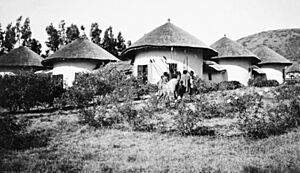
Early homes were usually round huts made of mud and straw on a wooden frame, with thatched roofs. Addis Ababa grew fast without much planning. Nobles started to settle permanently, and neighborhoods (called sefer) were built on higher ground, separate from each other. Emperor Menelik also planted many eucalyptus trees along the city streets, which you can still see today.
The city's population grew quickly because of governors and their soldiers, a famine in 1892, and the Battle of Adwa. A land law in 1907, city management in 1909, and a railway system also helped the city grow. The Ethio-Djibouti Railways and the city's landscape also caused its borders to expand south.
Addis Ababa in the 20th Century
Before Italian Occupation (1916–1935)
Gebrehiwot Baykedagn took on important government roles and helped with the Addis Ababa–Djibouti railway in 1916. This railway connected Addis Ababa to the port of Djibouti. Haile Selassie I, who later became Emperor, became a powerful figure in the city in 1917. He wanted to modernize the city and helped new businesses grow.
In 1926 and 1927, the city's economy boomed, especially from coffee production. Wealthy people built new stone houses with European furniture and bought the latest cars. Banks also expanded. In 1926, there were 76 cars, and by 1930, there were 578. The first major road for cars opened between Addis Ababa and Djibouti.
In 1930, Emperor Haile Selassie was crowned. He brought new technologies like power lines and telephones. He also built several monuments, such as Meyazia 27 Square.
Italian Occupation (1936–1941)
Italian troops entered Addis Ababa on May 5, 1936, after their invasion. Unlike some other cities, Addis Ababa was not bombed. This meant its railway to Djibouti stayed working. The city became the capital for Italian East Africa until 1941. The Italians wanted to make Addis Ababa a more "colonial" city with a new master plan. Several architects worked on this plan, focusing on grand buildings and roads.
On May 5, 1941, the city was freed by Major Orde Wingate and Emperor Haile Selassie. This was exactly five years after the Emperor had left.
After Italian Occupation (1941–1974)
After the Italians left, Addis Ababa faced economic problems and fast population growth. In 1946, Haile Selassie invited a British city planner, Sir Patrick Abercrombie, to help make the city a beautiful capital for Africa. He planned green areas and ring roads to help with traffic.
Later, in 1959, another British team improved Abercrombie's plans for satellite towns. In 1965, a French team created another master plan, focusing on a main monumental road through the city.
Haile Selassie also helped create the Organisation of African Unity (OAU) in 1963. This group was later replaced by the African Union (AU), which also has its main office in Addis Ababa. The United Nations Economic Commission for Africa also has its headquarters here.
In 1965, students protested against the government, leading to a big movement. The 1973 oil crisis also affected the city. In 1974, students protested again, and Emperor Haile Selassie was removed from power by a group of police officers who called themselves the Derg.
The Derg Government (1974–1991)
After the Derg took power, much of the city's housing became rental property owned by the government. The population growth slowed down. In 1975, the Derg took over many private rental houses. Smaller houses were managed by local units called kebeles, while larger ones were managed by a government agency. The city's administrative areas grew to 25 woredas and 284 kebeles.
A Hungarian architect, C.K. Polonyi, helped plan the city's growth during the Derg period. He aimed to connect Addis Ababa with nearby rural areas and develop the inner city. He also helped redesign Meskel Square.
In 1986, an Italo-Ethiopian master plan was created by many experts. This plan focused on balancing city services like water supply. However, the Derg government delayed this plan for eight years, which caused problems with public services and unplanned growth.
Federal Democratic Republic (since 1991)
On May 28, 1991, the Ethiopian People's Revolutionary Democratic Front (EPRDF) took control of Addis Ababa, ending the Derg rule. Residents were told everything was safe. The military took control of important places like the presidential palace.
A new constitution was approved in 1994. Addis Ababa and Dire Dawa became special cities that could govern themselves. Many government buildings were privatized, but the kebele buildings remained.
Addis Ababa in the 21st Century
From 1998, a new project called the Office for Revision of Addis Ababa Master Plan (ORAAMP) was launched. This plan aimed to help the city fit into a market economy and improve its urban areas.
2014 Addis Ababa Master Plan
A plan to expand Addis Ababa's borders into the Oromia special zone in 2014 caused protests. The government responded, and sadly, many protesters were killed. The controversial plan was canceled on January 12, 2016.
Recent Developments
In 2022, the population of Addis Ababa's metro area was estimated to be 5.2 million. During Abiy Ahmed's time as Prime Minister, Addis Ababa started a project called "Beautifying Sheger" to make the city greener and more beautiful. In 2018, Abiy started the "Riverside" project to improve riverbanks for 56 kilometers. In October 2022, the government launched Sheger City, a new urban development model with 12 sub-cities. This project aims to connect smaller cities to Addis Ababa and help with economic growth.
Addis Ababa and the Amhara People
Addis Ababa and the Amhara region have strong connections because of history, government, and culture.
Historical and Government Importance
Addis Ababa is the political and administrative center of Ethiopia. It plays a key role in how the country is governed, including the Amhara region. The Amhara region is north of Addis Ababa. This closeness means that decisions made in the capital can greatly affect the Amhara region.
Economic and Social Connections
Addis Ababa is a central place for business, education, and services. Many people from the Amhara region move to Addis Ababa for school and job opportunities. This has created many social and economic links between the two areas.
Cultural Links
The Amhara people speak Amharic, which is also the main language of the federal government. Addis Ababa is a mix of Ethiopia's many cultures, including those from the Amhara region.
Infrastructure and Growth
New buildings and improvements in Addis Ababa often help the surrounding regions, like Amhara. Better transportation, for example, can make it easier to travel between the city and the region.
Overall, the relationship between Addis Ababa and the Amhara region is deeply connected to Ethiopia's wider politics, economy, and culture.
Addis Ababa and Oromia Regional State
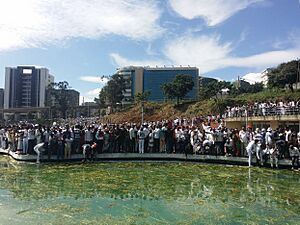
Addis Ababa is located in the middle of the Oromia state. The Oromia state provides many important natural resources to the city. The city was taken over by Menelik in the late 1800s. Oromos were sometimes moved away from the city during earlier governments.
Ethiopia's constitution says that the Oromia State has special interests in Addis Ababa. This includes things like social services, using natural resources, and shared government matters because Addis Ababa is located within Oromia.
In 2000, Oromia's capital was moved from Addis Ababa to Adama. This caused many protests. So, in 2005, the Oromo Peoples' Democratic Organization announced plans to move the capital back to Addis Ababa. Because of the historical and natural ties between the city and the Oromo people, the Oromia Government has said it has a claim to Addis Ababa. Both the current mayor, Adanech Abebe, and the former mayor, Takele Uma Banti, are from the Oromo Democratic Party.
Geography of Addis Ababa
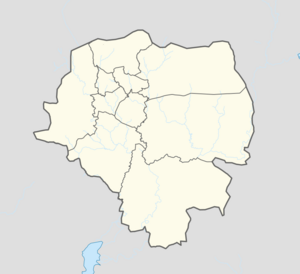
Addis Ababa is located at an elevation of 2,355 meters (7,726 feet) above sea level. It is a grassland area. The city sits at the foot of Mount Entoto and is part of the area that drains into the Awash River. The city's lowest point is near Bole International Airport, at 2,326 meters (7,631 feet). It rises to over 3,000 meters (9,800 feet) in the Entoto Mountains to the north.
City Divisions (Subdivisions)
The city is divided into 10 main areas called subcities (kifle ketema). These subcities are further divided into 99 smaller areas called wards (kebele). In 2020, an eleventh sub-city, Lemi-Kura, was added.
*Lemi-Kura sub-city was added as the eleventh sub-city of Addis Ababa in 2020
Climate of Addis Ababa
| Weather chart for Addis Ababa | |||||||||||||||||||||||||||||||||||||||||||||||
|---|---|---|---|---|---|---|---|---|---|---|---|---|---|---|---|---|---|---|---|---|---|---|---|---|---|---|---|---|---|---|---|---|---|---|---|---|---|---|---|---|---|---|---|---|---|---|---|
| J | F | M | A | M | J | J | A | S | O | N | D | ||||||||||||||||||||||||||||||||||||
|
13
24
7
|
30
25
9
|
58
25
11
|
82
25
11
|
84
25
11
|
138
23
11
|
280
21
11
|
290
21
11
|
149
22
11
|
27
24
9
|
7
23
7
|
7
23
7
|
||||||||||||||||||||||||||||||||||||
| temperatures in °C precipitation totals in mm source: NMAE |
|||||||||||||||||||||||||||||||||||||||||||||||
|
Imperial conversion
|
|||||||||||||||||||||||||||||||||||||||||||||||
Addis Ababa has a subtropical highland climate. This means it has cool temperatures all year because of its high elevation. Temperatures can change by up to 10°C depending on how high up you are and the wind. Since it's near the Equator, temperatures stay very steady each month.
- Dry Season (Mid-November to January): This is the dry season. Daytime temperatures are usually below 23°C, and nighttime temperatures can drop to freezing.
- Short Rainy Season (February to May): During this time, the city has warm temperatures and pleasant rain. Nighttime temperatures are usually between 10°C and 15°C.
- Long Wet Season (June to Mid-September): This is the coldest time of the year. Even though it's summer, temperatures are lower because of frequent rain, hail, and lots of clouds. Days and nights are often dark, chilly, and wet.
- Autumn (After Mid-September): This is a time of change between the wet and dry seasons.
The highest temperature ever recorded was 30.6°C on February 26, 2019. The lowest temperature ever recorded was 0°C, which happened several times.
| Climate data for Addis Ababa (1991-2020, extrems 1898-present) | |||||||||||||
|---|---|---|---|---|---|---|---|---|---|---|---|---|---|
| Month | Jan | Feb | Mar | Apr | May | Jun | Jul | Aug | Sep | Oct | Nov | Dec | Year |
| Record high °C (°F) | 28.8 (83.8) |
30.6 (87.1) |
30.0 (86.0) |
30.2 (86.4) |
29.6 (85.3) |
29.0 (84.2) |
29.1 (84.4) |
28.0 (82.4) |
25.6 (78.1) |
27.1 (80.8) |
29.7 (85.5) |
26.5 (79.7) |
30.6 (87.1) |
| Mean daily maximum °C (°F) | 23.9 (75.0) |
25.3 (77.5) |
25.8 (78.4) |
25.4 (77.7) |
25.3 (77.5) |
23.6 (74.5) |
21.2 (70.2) |
20.9 (69.6) |
21.9 (71.4) |
23.3 (73.9) |
23.3 (73.9) |
23.1 (73.6) |
23.6 (74.5) |
| Daily mean °C (°F) | 16.3 (61.3) |
17.6 (63.7) |
18.6 (65.5) |
18.8 (65.8) |
18.8 (65.8) |
17.5 (63.5) |
16.5 (61.7) |
16.4 (61.5) |
16.6 (61.9) |
16.5 (61.7) |
15.9 (60.6) |
15.5 (59.9) |
17.1 (62.8) |
| Mean daily minimum °C (°F) | 8.6 (47.5) |
9.9 (49.8) |
11.6 (52.9) |
12.2 (54.0) |
12.2 (54.0) |
11.7 (53.1) |
11.9 (53.4) |
11.8 (53.2) |
11.3 (52.3) |
9.7 (49.5) |
8.3 (46.9) |
7.5 (45.5) |
10.6 (51.1) |
| Record low °C (°F) | 0.0 (32.0) |
0.0 (32.0) |
0.0 (32.0) |
2.5 (36.5) |
4.0 (39.2) |
4.2 (39.6) |
5.4 (41.7) |
5.7 (42.3) |
3.9 (39.0) |
0.0 (32.0) |
0.0 (32.0) |
0.0 (32.0) |
0.0 (32.0) |
| Average rainfall mm (inches) | 13 (0.5) |
30 (1.2) |
58 (2.3) |
82 (3.2) |
84 (3.3) |
138 (5.4) |
280 (11.0) |
290 (11.4) |
149 (5.9) |
27 (1.1) |
7 (0.3) |
7 (0.3) |
1,165 (45.9) |
| Average rainy days (≥ 0.1 mm) | 3 | 5 | 7 | 10 | 10 | 20 | 27 | 26 | 18 | 4 | 1 | 1 | 132 |
| Average relative humidity (%) | 52 | 51 | 53 | 59 | 55 | 68 | 78 | 80 | 75 | 57 | 53 | 53 | 62 |
| Mean monthly sunshine hours | 266.6 | 206.2 | 241.8 | 210.0 | 238.7 | 174.0 | 111.6 | 133.3 | 162.0 | 248.0 | 267.0 | 288.3 | 2,547.5 |
| Mean daily sunshine hours | 8.6 | 7.3 | 7.8 | 7.0 | 7.7 | 5.8 | 3.6 | 4.3 | 5.4 | 8.0 | 8.9 | 9.3 | 7.0 |
| Source 1: Météo Climat | |||||||||||||
| Source 2: World Meteorological Organisation (rainfall 1981–2010), Deutscher Wetterdienst (humidity 1951–1990, and sun 1985–1998) | |||||||||||||
People of Addis Ababa
In 2007, Addis Ababa had about 2.7 million people. There were 662,728 households, with about 5.3 people per household. All of Ethiopia's different ethnic groups live in Addis Ababa because it's the capital.
The largest groups include:
- Amhara (47.05%)
- Oromo (19.51%)
- Gurage (16.34%)
- Tigrayan (6.18%)
- Silt'e (2.94%)
- Gamo (1.68%)
The main languages spoken are:
Most people in Addis Ababa are Christian, belonging to the Ethiopian Orthodox Tewahido Church (43%). Other religions include Muslim (33%) and Protestant (20%).
Ethnic groups of Addis Ababa (2007) Amhara (47.05%) Oromo (19.51%) Gurage (16.34%) Tigrayan (6.18%) Silt'e (2.94%) Gamo (1.68%) Other (6.3%)
Religion in Addis Ababa (2007) Ethiopian Orthodox (74.6%) Muslim (16.2%) P'ent'ay (7.8%) Traditional faiths (0.1%) Catholic (0.5%) Other (0.8%)
In 1994, the city's population was about 2.1 million. Most homes in Addis Ababa (98.64%) had access to safe drinking water in 2007. About 14.9% had flush toilets. The adult literacy rate (people who can read and write) was very high: 93.6% for men and 79.95% for women. This was the highest in Ethiopia.
| Historical population | ||
|---|---|---|
| Year | Pop. | ±% |
| 1984 | 1,412,575 | — |
| 1994 | 2,112,737 | +49.6% |
| 2007 | 2,739,551 | +29.7% |
| 2023 | 3,945,000 | +44.0% |
| source: | ||
Economy of Addis Ababa
Addis Ababa has many different types of jobs. Government numbers show that many people work in:
- Trade and business (about 119,197 people)
- Manufacturing and industry (about 113,977 people)
- Civil administration (about 71,186 people)
- Transport and communication (about 50,538 people)
- Education, health, and social services (about 42,514 people)
- Hotel and catering services (about 32,685 people)
- Agriculture (about 16,602 people)
Even city dwellers raise animals and grow gardens. About 677 hectares of land are used to grow vegetables each year. Addis Ababa is a relatively clean and safe city. It has been building many new tall buildings and luxury services lately, including shopping malls. Some people even call it "the spa capital of Africa."
Ethiopian Airlines has its main office at Addis Ababa Bole International Airport.
City Development
The city has a "We Are the Future" center, which is a childcare center that helps children have a better life. This center is managed by the mayor's office.
Tourism in Addis Ababa
Tourism is growing in Addis Ababa and all of Ethiopia. In 2015, Ethiopia was named the best country for tourists by the European Council on Tourism and Trade. However, the COVID-19 pandemic and the Tigray War caused tourism to decrease.
Addis Ababa Zoo
The Addis Ababa Zoo had 15 lions in 2011. Scientists studied their hair samples and found that they had diverse genes. Because of this, it was suggested that these lions should be part of a program to breed them in captivity.
Places of Worship
Addis Ababa has many places of worship, mostly Christian churches and Muslim mosques.
Some important churches include:
- Saint George's Cathedral: Founded in 1896, this church has a museum with old weapons. It was damaged by the Italian government in 1937 but rebuilt after Ethiopia was freed in 1941. It's an octagonal building.
- Holy Trinity Cathedral: This is the largest and highest cathedral in Ethiopia. It was built to celebrate the victory against the Italian invasion. It's also the burial place for many important people, including Emperor Haile Selassie and his wife.
- Ba'etta Mariam Orthodox Church: This church is part of the Menelik Palace and Mausoleum.
The most famous mosque is the Grand Anwar Mosque, located in the Merkato area. It was built in 1922. The Nur Mosque is an older Islamic temple that was recently rebuilt. The closeness of the mosque and churches shows the long history of peaceful relations between Christians and Muslims in Ethiopia.
Architecture of Addis Ababa
Addis Ababa is building a new financial district.
The city is the main office for the United Nations Economic Commission for Africa and the African Union.
Some notable tall buildings in Addis Ababa include the CBE headquarters, NIB International Bank, Zemen Bank, and Hibret Bank. The AU Conference Center and Office Complex is also a very important building.
Other important buildings are:
- St George's Cathedral (built in 1896)
- Holy Trinity Cathedral (where Emperor Haile Selassie is buried)
In the Merkato district, which is Africa's largest open market, you'll find the Grand Anwar Mosque. Near it is the Raguel Church. The closeness of these two places of worship shows the peaceful relationship between Christians and Muslims in Ethiopia. The Roman Catholic Cathedral of the Holy Family is also in Merkato. Near Bole International Airport is the new Medhane Alem Orthodox Cathedral, which is the second-largest in Africa.
The Entoto Mountains are in the northern part of the city. Some suburbs include Shiro Meda, Urael, and Bole (where the airport is). Kolfe was mentioned in Nelson Mandela's book as the place where he received military training.
Addis Ababa has its own unique architectural style. Unlike many African cities, it was not built by colonial powers. This means it didn't have a European style at first. This changed after the Italian occupation in 1936. The Piazza district in the city center clearly shows Italian influence with its buildings, restaurants, and cafes.
Parks in the city include Africa Park and Unity Park.
Other city features include the large Mercato market, the Jan Meda racecourse, and a railway line to Djibouti.
The city is home to several museums:
- Ethiopian National Library
- Ethnological Museum
- Addis Ababa Museum
- Ethiopian Natural History Museum
- Ethiopian Railway Museum
- National Postal Museum
Menelik's old Imperial palace is still the official seat of government. The National Palace is where the President of Ethiopia lives. Africa Hall is where the United Nations Economic Commission for Africa has its headquarters. It's also where the Organisation of African Unity (OAU) was founded. The African Union (AU) now has a new headquarters built on land donated by Ethiopia. The Hager Fikir Theatre is the oldest theater in Ethiopia. The Parliament building, with its clock tower, was built during Emperor Haile Selassie's time and is still used today. The Shengo Hall, built by the Derg government, is used for large meetings. Itegue Taitu Hotel, built in 1898, was the first hotel in Ethiopia.
Meskel Square is a famous square in the city. Thousands of people gather there each year for the annual Meskel celebration in September.
The fossilized skeleton of an early human ancestor named Lucy (also called Dinkinesh) is kept at the National Museum of Ethiopia.
Culture in Addis Ababa
Addis Ababa is a place where many different communities from all over Ethiopia come together. People from different backgrounds often mix and share their cultures here.
Arts and Museums
The National Museum of Ethiopia holds many old items and art treasures from Ethiopia. It also has exhibits about archaeology. You can see parts of the skeleton of Australopithecus afarensis, known as Lucy, and her successor Selam. The museum also has many ceremonial clothes from the Solomonic dynasty. The art includes works by Afewerk Tekle, a famous artist, and pictures showing the meeting between Solomon and the Queen of Sheba.
Theatres and Cinemas
Addis Ababa has many theaters, including the old Hager Fikir Theatre, where many famous people have performed. The Ethiopian National Theatre is also in the city. It was started by Emperor Haile Selassie in 1955. In the past, Amhara culture was very important in Ethiopian art, with rituals linked to the Coptic church.
Modern European plays were introduced around 1916. Many playwrights became famous. During the Derg era, new theaters opened. Today, the city continues to develop its cultural life.
Some modern cinemas include:
- Children Youth Theatre
- Agona Cinema
- Haile & Alem Inter
- Cinema Yoftahe
- Sebastopol
- Matin Multiplex
Science and Technology
Addis Ababa has many science and research centers. The Addis Ababa Science and Technology University aims to help Ethiopia become an industrialized country. It was founded in 2011. The city is also home to the Science and Technology Information Center. Addis Ababa has a science museum with interactive exhibits. The Ethiopian Biotechnology Institute is another important science facility.
Media in Addis Ababa
Addis Ababa has the most mass media in Ethiopia. Radio stations are usually owned by the government, but there are also many community stations. The Ethiopian Broadcasting Corporation is a public broadcaster with its main office in Addis Ababa. Private television channels started in 2008 with EBS TV, and many more grew after 2016, like Kana TV and Fana TV.
Sports in Addis Ababa
Addis Ababa hosts major sports events, like the Jan Meda International Cross Country race. It also hosts the yearly 10 km road race called the Great Ethiopian Run. This race was started by famous athlete Haile Gebrselassie in 2000.
Addis Ababa is home to several stadiums:
- Addis Ababa Stadium
- Abebe Bikila Stadium (named after the famous runner Abebe Bikila)
- Nyala Stadium
The 2008 African Championships in Athletics were held in Addis Ababa.
Education in Addis Ababa
Emperor Menelik II began modernizing education in Addis Ababa in the early 1900s. He replaced old Christian schools with new, non-religious ones. The first modern school opened in 1906. Menelik encouraged more schools and even made parents send their children to school.
Addis Ababa University was founded in 1950. It was first called "University College of Addis Ababa." In 1962, it was renamed after Emperor Haile Selassie I, who had given his palace to be the university's main campus. It is home to the Institute of Ethiopian Studies and the Ethnological Museum. The city also has many other public and private universities and colleges, including Addis Ababa Science and Technology University and St. Mary's University.
In 2002, a businesswoman named Zemi Yenus started a school for children with autism called the Joy Center. It moved to a bigger building within two years.
In 2022, the new Abrehot Library was finished. It is the largest library in Ethiopia.
More private schools are opening in Addis Ababa because people want good quality education. Parents often prefer to send their children to private schools rather than government ones. Private primary schools are often better at managing money and following educational rules.
| School level | Year | |
|---|---|---|
| 1994/95 | 2001/02 | |
| Kindergarten (KGs) | 52 | 292 |
| Primary schools | – | 287 |
| Secondary schools | 5 | 31 |
| TVET schools | 0 | 7 |
| Colleges | 0 | 10 |
Transportation in Addis Ababa
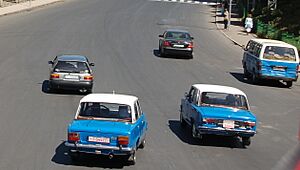
Public transport in Addis Ababa includes public buses from three companies, Light Rail, and blue and white taxis. The taxis are usually minibuses that hold up to twelve people and follow set routes. These minibus taxis have a driver and a weyala who collects fares and calls out the destination. Regular sedan taxis also operate. Recently, new taxi companies with yellow sedans and ride-hailing apps have become popular.
Roads in Addis Ababa
The Addis Ababa Ring Road was started in 1998 to help the city grow and improve traffic flow. It connects all five main roads leading in and out of Addis Ababa to other regions of Ethiopia. The China Road and Bridge Corporation (CRBC) helped build this road. The Ring Road has greatly reduced traffic jams in the city.
Intercity bus service is provided by the Lion City Bus Services.
Air Travel
The city is served by Addis Ababa Bole International Airport. A new terminal opened there in 2003.
Railways
Addis Ababa used to have a railway connection to Djibouti City, but this old route is no longer used. A new railway, the Addis Ababa-Djibouti Railway, started operating in September 2016. It runs alongside the old railway line.
Light Rail System
Addis Ababa opened its light rail system to the public on September 20, 2015. This was the first light rail system of its kind in sub-Saharan Africa.
The Ethiopian Railway Corporation got funding from the Export and Import Bank of China in 2010. The light rail project was finished in January 2015. The system is 34.25 kilometers long and has two lines. One line runs from the city center to the south. The other line will run from Ayat to the Torhailoch ring-road, and from Menelik Square to Merkato Bus Station, Meskel Square, and Akaki.
Sister Cities
Addis Ababa is connected with these cities around the world:
Images for kids
Notable People from Addis Ababa
- Ephraim Isaac: Scholar of Ancient Semitic Studies
- Mohammed Hussein Al Amoudi: Richest person in Ethiopia
- Haile Gebrselassie: Ethiopian long-distance runner
- Kenenisa Bekele: Ethiopian long-distance runner
- Tedros Adhanom: Director-General of the World Health Organization (WHO)
- Saladin Said: Ethiopian soccer player
- Mahder Assefa: Actress
- Mulatu Astatke: Ethiopian Jazz musician
- Mahmoud Ahmed: Ethiopian singer
- Teddy Afro: Ethiopian singer
- Bethlehem Tilahun Alemu: Founder of Sole Rebels
- Eténèsh Wassié: Ethiopian azmari (traditional musician)
- Ruth Negga: Actress
- Zemi Yenus: Autism awareness advocate
See also
 In Spanish: Adís Abeba para niños
In Spanish: Adís Abeba para niños


